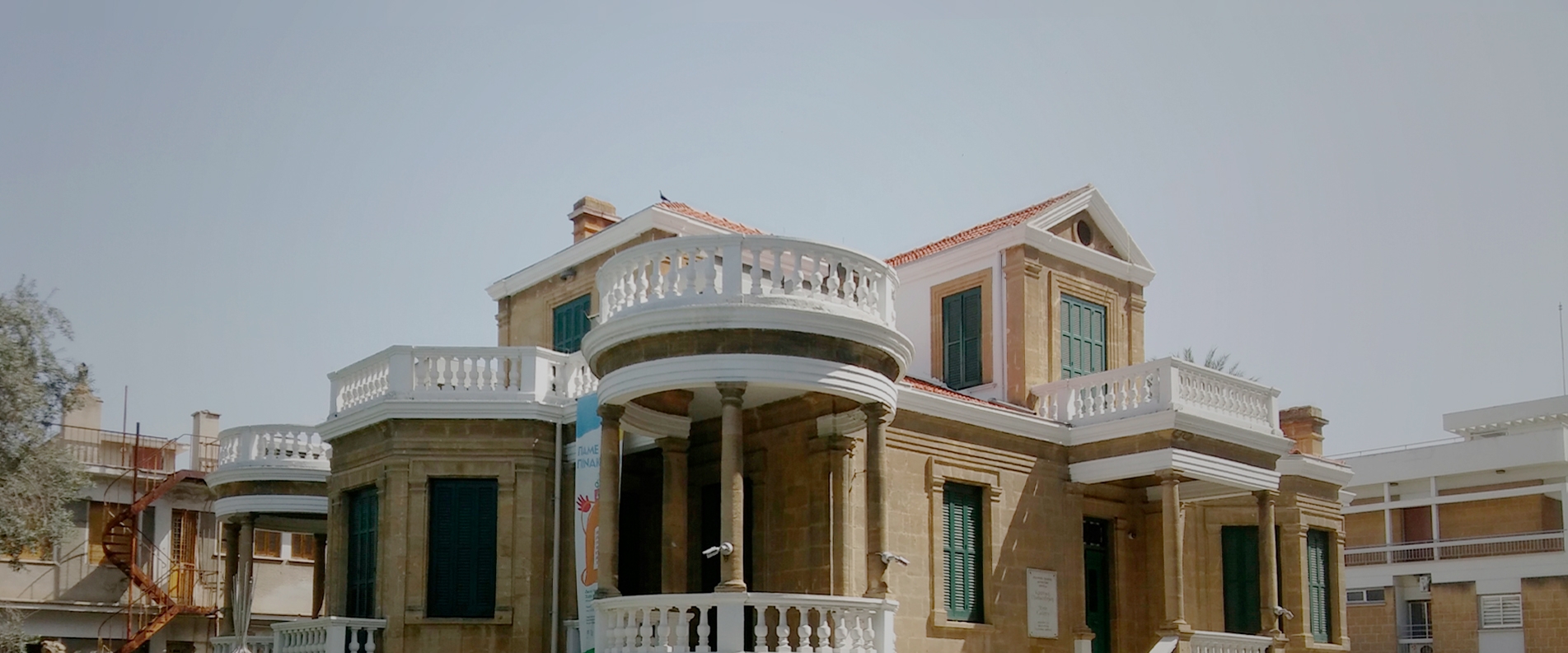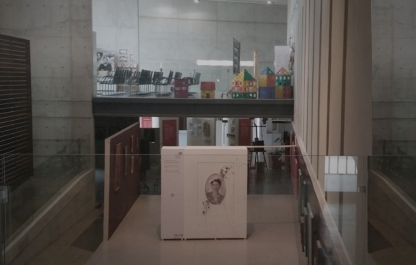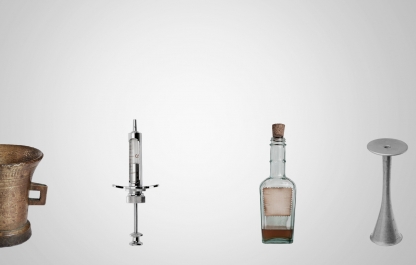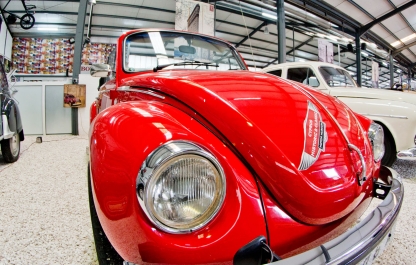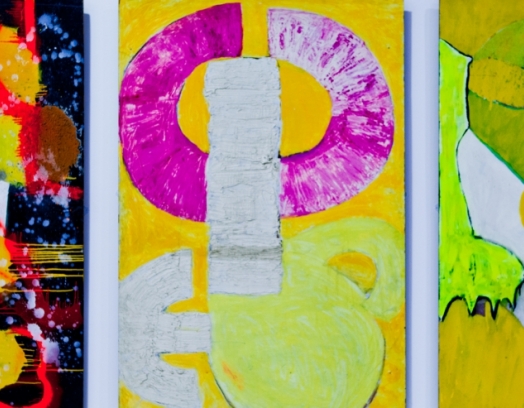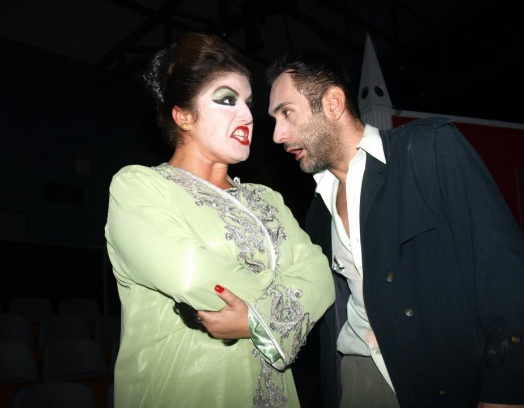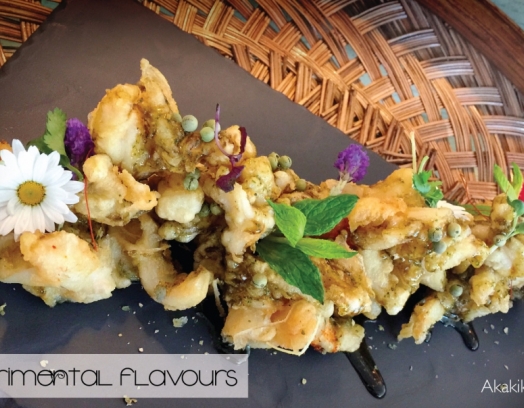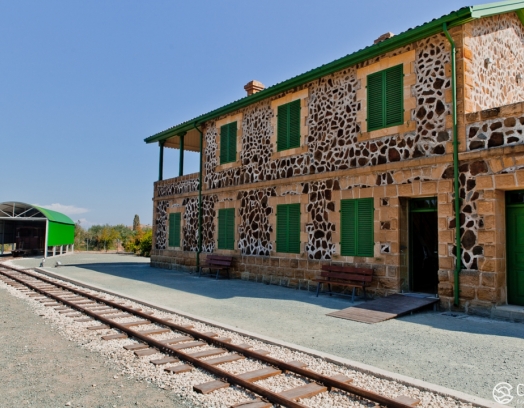«Art has always been the language of visual communication between nations and through time. The dream and spirituality that radiates from the painting takes you on a voyage of hidden enchantment and poetry.»
Costas Joachim (famous Cypriot artist, 2012)
Today we will visit the permanent exhibition [1] of State Gallery of Contemporary Art in Nicosia. The gallery’s collection consists of more than 400 works of painting, graphic art, sculpture and ceramics, video art and other pieces created by significant artists of different generations.
You will have the opportunity to trace the whole retrospective of developing of Cypriot fine art and its main representatives of the last 100 years, to begin with the first half of the 20th century, as well as see the modern works created with the help of new non-traditional ways of artistic expression.

The reason why the works in the Gallery halls are not always representing the creative flowering of the certain local artist is that the main idea of the Gallery founders was to highlight the milestones and development paths of national Cypriot art in general.
Placed under the responsibility of the Cultural Services of the Ministry of Education and Culture of Cyprus, the Gallery has — apart from exhibition halls — a study hall with an archive and library containing information about Cypriot art and artists.
Both visitors who became interested and those who are making a research of the works of certain painter, sculptor or graphic artist can learn here about their biographies, see slide presentations and other photographic materials.
The Gallery often works also as a place for lectures, art biennales, concerts and other musical performances. There are educational courses for children that are supported by the Ministry of Education and Culture and take place every week like this one for example — the event was a part of the educational program dedicated to International Museum Day 2017.
Situated inside the neo classic style building [2] (constructed in 1925-26, the architect and the first owner of the house was Michalakis Kulumbis) since 1990, the collection is quite impressive and includes works of many local and few foreign artists for which Cyprus became the second home.
The members of the special commission that made selection and acquisition of the future exhibits of the Gallery were: art historians Niki Loizidou and Nikos Hadjinicolaou, artists George Kotsonis and Andreas Efesopoulos, ceramist Valentinos Charalampus and others.
The exhibition illuminates the art culture of the island and works of its significant representatives in a chronological order from the beginning of the 20th century to contemporary times, thus allowing to track the evolution of the fine arts from the “old masters” to the contemporaries.
Historical Summary
It is generally accepted that there was no academic art in Cyprus till the beginning of the 20th century and the evidence of it is that practically there weren’t any other kind of art except religious and folk in the country in 19th century.
Agrarian-based society and the absence of its own fine art school tradition did not facilitate the development of the academic arts.
It is known [3] that the first Cypriot who studied art abroad was a poet Vasilis Michaelides (1849-1917). However he had never finished his education and left the art turning to poetry after his return to Cyprus.
A pioneer artist of local art (or at least one of them) is considered to be a writer and painter Nicos Nicolaides.
However the most famous among the artists of Cyprus was Andreas Timopulos (1881-1953) who devoted his life to the fine arts and have studied sculpture in Greece (Athens). He was the one who introduced Cypriots to Greek ways of teaching arts in the first decade of 20th century.
Another “old master” from Cyprus that is well known worldwide was Vasilis Vrionides (1882-1958). He studied painting in Venice and Paris, so it’s no wonder that his works shows the influence of Venice renaissance and French postimpressionism.
We will see in the halls of the Gallery paintings of Ioannis Kissonergis (1889-1963) as well. Characteristic for his works are genre scenes and realistic landscapes.
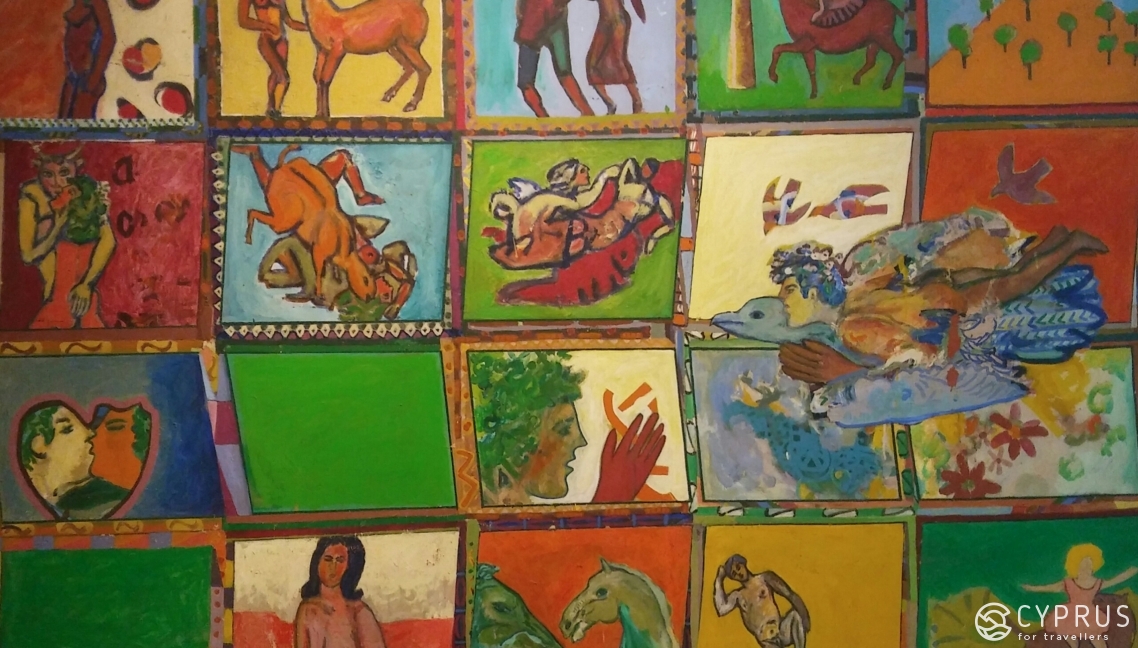
The artists we’ve named above paved the way for the new generations with their works.
Here are some more names without which it’s impossible to imagine the art of Cyprus: Adamantios Diamantēs (1900-1974) and George Georgiou (1901-1972), Solonos Frangulidis (1902-1981) and Victor Ioannides (1903-1984) both painted in realistic and impressionistic style; Loukia Nicolaidou-Vassiliou (1909-1994) who was the first female painter in Cyprus and others.
The main part of them, with few exceptions, were professional artists who studied abroad and then returned to Cyprus enriching its culture with their art works and making it popular.
As a rule the starting point of their creativity was personal experience. The main themes of the works were: the nature and people around them, daily routines and historical events. All these parts of life were reflected using rich artistic language, which reflects very own conceptions and messages of each artist.
Their followers considered to be those Cypriot artists who continue to paint same themes and use similar artistic language as for example: Lefteris Economou (born in 1930), Eleni Chariklidou (1926-1988) and others.
Thus, the researchers describe the art in Cyprus in the first half of the 20th century as some act of self-discovery of an artist, an attempt to protect the ancient roots and to reveal the socio-cultural features of the humans and the beauty of the natural environment.
The spirit of modernism in the culture of Cyprus became evident only after the establishment of the Republic of Cyprus in 1960 and a favourable environment for the art development on the island by creating institutions that supported talented youth and encouraged the interest to the art among the people. It symbolized the artistic search, the wish of renewal and break with traditions in some way. So Cyprus slowly began to go international in the end of 1960es.
We will see the paintings of Christophoros Savva (1924-1968) in the Gallery halls today. His works would serve as a bridge between the eras and periods of Cypriot art. He was a founder of Pancyprian Artists Association organized in 1950. He opened first art gallery “Apophazis” ten years later together with his friend British abstract painter Glyn Hughes (1931-2014) who spent most of his life in Cyprus and became one of the most significant masters of contemporary art. Hughes contributed to convergence of art with literature, music and theatre what made possible the dialogue between the kinds of art and its creators.
It was time of intellectual artists; one of them was Stelios Votsis. The art for him was in forms and colours that are intentionally deprived and in the atmosphere and allusions of the creator that became the key to the mysteries of life. Two female abstract painters: Kate Stefanidou and Vera Hadjida are following the same principles in their works.
Let’s not forget about other tendencies in Cypriot art that developed together with searches of non-figurative style and experiments.
Some artists sought inspiration and saw the new ways for the artistic expression in the depths of the past using primitive cultural symbolism and turning to “primitive” myth (as for example Yiorgos Skotinos and some others).
-
Sculpture was going through the same metamorphosis as painting and graphic and looked for new alternative goals: for example, Cypriots who studied sculpture in the Great Britain were influenced by its tendencies and turned to the tectonic elements in an effort to reflect the features of their inner and external “rhytms” searching for some kind of dialogue between the void and the existence.
While some of them used “density” and emphasis on biomorphic shapes (Andis Hajiadamos, 1936-1990), the others were discovering the kinetic art (George Sfikas, Dimitris Constantinou, Andreas Savvidis and others).
Tragic national, political and cultural consequences of the Turkish occupation in 1974 pushed those artists whose works were connected with the local history and epics to reflect these events and national drama. Some artists began to use realistic shapes (Kanthos Telemachos) while others described acute social and political themes with the help of abstract shapes and the language of expressionism (Hambis Tsangaris and others).
Speaking of 1980-90es it is worth mentioning that the variety of themes and expressivity of presentation forms widened at this time: it can be found in works of George Kotsonis, Andreas Karayan, Anna Constantinou and many others. Despite the development of new artistic forms and directions in the last decades the old ones continue to exist, sometimes in a very modified state, and enrich the Cyprus art that turned to the dialogue between the extremes: between the concepts and antagonistic appearances on the existential fronts.
All these trends are connecting the local works of such painters as Ioannis, Kula Savvidou, Christos Foukaras, Stavros Antonopoulos and many others with the foreign contemporary art.
As for the youngest generation of the painters whose works are shown in the Gallery exposition, you can see the process of creating the “new mythology” in the art of Cyprus.
How about an excursion through the Gallery halls to see everything with your own eyes?
The permanent exhibition takes three floors.
You can see the paintings of old masters such as Ioannis Kissonergis (1889-1963) — genre works and landscapes from different years as well as avant-garde artworks (oil on a cardboard, wood and canvas) right at the entrance to the exhibition. In front of you, to the right from the entrance are shown the interesting works of another significant Cyprus artist — Michael Kashalos (1881-1974). We’ve already seen his paintings at the Cyprus Folk Art Museum in Nicosia. Michael Kashalos worked in so called “naïve” art style: among his works are “Sacred procession”, “Coffee shop” and alludes to the Greek epos “Erotokritos and Arethousa” — an artwork inspired by verse romance of the Venetian period; all three paintings are oil on cardboard. By the way, those who are interested in world art and have seen the unforgettable paintings of Georgian artist Niko Pirosmani will find similar elements in the works of his Cyprus “colleague”.
As for me, I love this style in art since my childhood because the painters (many of them traditionally were self-taught) keep the “innocent” sense of reality that is common for children. You can literally “travel” through their paintings every time discovering new details that describe the whole stories captured on canvas.
I want to tell you a bit more about this artist because as it’s always the case, the destiny of the recognized “father” of contemporary Cypriot art captures just as much as his artworks.
Michael Kashalos was a self-taught artist, born in Assia village in 1885. He attended icon-painting classes in primary school held by icon painter Kyriacos Pierides. Kashalos learnt the profession of a shoemaker and worked until the World War II but then started mirror design and glass painting. He was a talented ceramist; he made different decorative pieces and copies of ancient artifacts (some of them you can see in the Gallery).
He devoted himself entirely to the art in 1957. Michael Kashalos was severely wounded during the attack of the Turkish soldiers on the village at the time of occupation. He died of his wounds on 31st of August in the Greek refugees camp in Larnaka.
Today his works are displayed, except the Gallery, in the Cyprus Folk Art Museum, the Laiki Bank Cultural Centre and several of them are kept in private collections.
The artistic heritage of Michael Kashalos draws a line under the artistic culture of Cyprus from the ancient days to the 20th century. Modern folk art shows in its features the influence of all the historical periods Cyprus and its people went through.
-
Let’s keep going. And soon you will see bronze sculpture in front of you — portrait by Telemachos Kanthos (1910-1993) — one of the most famous Cypriot painters, called also “a poet of art” by Spanos Leonidas. The bust was made in 1997.
The following works were created under the influence and impression of European masterpieces made by contemporaries of old Cypriot masters in different styles like: abstractionism, cubism, expressionism, fauvism and others.
Drafts of figures and a part of future painting “Theodoros — the violinist” (1971, acryl paints on canvas) made by Adamantios Diamantis (1900-1974) set out among other works. The finished monumental artwork — frieze “The World of Cyprus” is the jewel of the collection in Leventis Art Gallery in Nicosia.
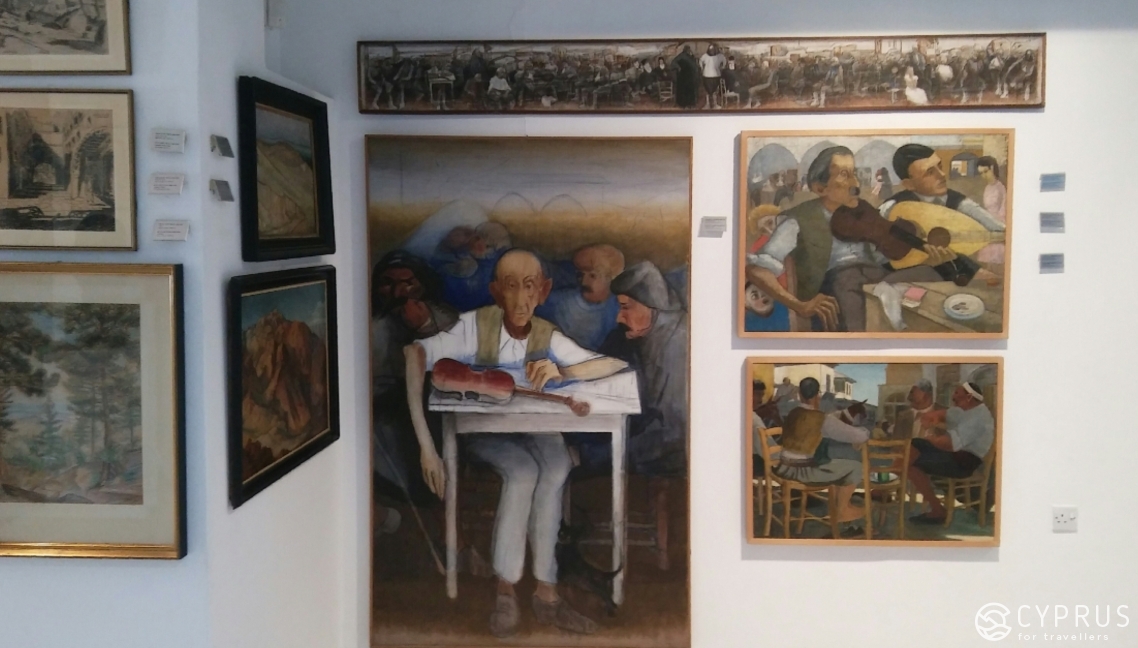
These works are oil on canvas, however the painter used light almost transparent brushstrokes, through which pigments you can see the original charcoal drawing; its details sometimes differ from the last version of painting chosen by the artist.
The works hanging nearby are mountain landscapes of Cyprus by Nicos Nicholaides (1884-1956).
The main part of the artworks located on the first floor are emotional dramatically acute and full of uncovered reflection expressionist paintings depicting historical realities of the destiny of the island: A. Diamantis with his works “Woman with outstretched hands” (acryl paints on canvas, 1983-84), “Women and oxes” etc.
The painters all around Cyprus were often inspired by the “roof motives”.
If you go up on the roof of any building that is higher than traditional houses in old parts of any city in Cyprus and look around, you could definitely spend a couple of hours observing the views of geometrical shapes and lines and various colour palettes. Time “painted” the roofs using its own tools: there are darkened in the sun and burnt roofs of old houses and villas, roofs with damp stains and roofs covered with moss. How could you resist becoming a “roof poet”!
However the collection of paintings includes not only urban views and village landscapes but also reflects works on the land, speaking about “old school” painters, majorities of their works are dedicated to this theme because Cyprus was traditionally an agrarian country: large-scale canvas “Women planting” by Adamtios Diamantis and many others.
Victor Ioannides — an illustrator of Great Greek Encyclopedia (Μεγάλη Ελληνική Εγκυκλοπαίδεια), art teacher and caricaturist.
His works that are part of the permanent exposition will definitely remind many of you of Van Gogh’s paintings: still life and landscapes contain a mix of local elements with purely European postimpressionist style.
We’re standing in front of realistic portrait of Coralia Savva Louizides (1936) by another famous, well-respected and esteemed (especially in Agros) Cypriot painter.
By the way you can read more about the masters whose art works exhibited in the State Gallery of Contemporary Art in many different sources including our previous articles, for example here, here and here.
And now I want to tell you about one more painter whose artworks I discovered recently.
Solomos (Solonos) Frangoulides
Except the portrait (that was a revelation for me, because I was quite unfamiliar with his works and has known him mostly for his lyrical landscapes and icon paintings) you can see some landscapes painted by Solomos Frangoulides.
The painter was born in Pano Zodia village in 1902. He took his first painting classes by Russian painter Ilia Karisiev who moved to Cyprus after the October Revolution in Russia. Solonos attended the school of fine arts in Athens (1924-1930) where he studied under the lead of C. Iakovidis, N. Litra and Spyros Bikato. The painter returned to Cyprus in 1932 and worked here for two years painting the interior of the main church of Agros and creating icon paintings for it.
Frangoulides lived in Athens again in 1934-1947 where he was working as a designer but the later period of the artist’s work was connected with Cyprus. He represented the first generation of the Cypriot artists; his works, not only lyrical landscapes and realistic portraits but also icon paintings for different Cyprus churches were influenced by Italian and Byzantine art.
Solonos Frangoulides took part in personal and group exhibitions both in Cyprus and abroad many times. His works gained the appreciation of the contemporaries and are exhibited now in major state art collections in Greece, Cyprus and Russia.
-
In the second hall to the right you will find interesting artworks of woman artist (first of them who studied abroad) who became the most famous one in the history of art in Cyprus — Loukia Vassiliou Nicolaidou. Modern audience could find her painting “Enozis, a Dream of Cyprus” (1954-56) quite politicized; it’s an allegoric interpretation of the popular at that time idea of historical and ethnical association of people of Cyprus and Greece.
An interesting fact: the young artist wasn’t appreciated by the public in her motherland (her personal exhibition was held in 1933), most likely because of its conservatism. Later her career brought her to England where she moved then and where her works had resonance and were widely recognized. In her later years she almost left the art after her marriage with shipowner Ioannes Vassiliou.
Also here you will see several avant-garde landscapes painted by Loukia Nicolaidou (what is not a coincidence because her works were inspired by modernism). If you look at the pictures very closely, you can notice that she painted new ones on top of her earlier works.
-
Georgios Georgiou (1901-1972) — you will enjoy his paintings if you are a fan of expressionistic artworks of Amedeo Modigliani, the main theme of which is the human: both artists share sensuality and high emotionality, some influence of African art, flatness and geometry of constructing of shapes together with warm and quite bright palette — all these elements are mixed with religious themes as Christian fables and mythological scenes. Georgiou connected them with famous characters and realities of life in Cyprus.
The difference is that Modigliani sang the beauty of the women’s bodies while Georgiou used same techniques painting both female characters (for example “Virgin of Liopetri”, 1950; “Madonna of Peristerona”) and Christ and Saints (“Descent from the Cross”, 1953; “St. Spyridonas of Cyprus”, 1951). We are witnessing here obvious preference for stylization and intertwining of different motives.
So mythological themes that run like a scarlet thread through the contemporary art of Cyprus are not new for the local artists; they always inspired the painters to search new forms and new ways for self-expression with allegorical images and various stories.
It’s amazing that despite seeming profane and bold experimentation the art in Cyprus is inherently religious: for someone it’s solemn prays and canonical Orthodox images woven deeply into the life of the people, for others — eternal youth and “lightness of life” of ancient gods whose pace still echoes over the island; and for someone it’s the idea of denial of non-material and spiritual dimensions in the nature that comes in images similar to ancient way of thinking that inspires with its “dark” secrets and monsters, giants and other creatures hiding from the light and thereby staying beyond the cognition of a man.
Dikaios Charilaos (1912-2002) — a famous architect and painter born in Nicosia. His works contain elements of west European fauvism, a sense of irony (painting “Two priests”) and even a certain caricature motives; other his works are quite pastoral like “The Farm” and others.
Takis Frangoudis (1901-1978) — one of the local abstractionist painters, art critic: “Untitled” (oil).
Lefteris Economou — his impressionistic painting “Roof of Nicosia” (how else they would be?) and colourful picturesque “Card players. Recollections” (1994) are exhibited in the Gallery. The second reminded me the painting style of one of Russian avant-garde founders — Aristarkh Lentulov.
Tassos Stephanides (1917-1996); the feelings in his oil paintings go over the edge because of the unique combination of expressionism and “idealistic” abstractionism.
-
In front of this hall (to the left from the exit and the place you are staying at now) are a lecture room and a study hall. And now we are going up the wooden stairs (please note, there is a special elevator for people with disabilities) to the second floor.
Let me to take an aside and tell you how I was surprised by the way the museum staff treating the collection that is quite rare to see in Cyprus: all the windows are carefully closed with the thick curtains to reduce the affection of daylight and the lightning in the halls is also dimmed. And one more observation: you feel free to walk through the exhibition halls alone what helps to dive into the atmosphere and enjoy the artworks. But in this case all the information will remain “behind the scenes” then, however if you will have any questions you can come to the Gallery once again and make a request for a specific literature, buy one of the books sold on the first floor of the Gallery or just keep traveling with us from time to time.
Don’t hurry to go up (or already down) the stairs, take a minute to look at graphic works of Spyros Demeatriades (born in 1950). His drawing “Elisee. In Homer Avenue” (1981) is a masterpiece made in mixed techniques: watercolour and pencil on paper.
As you will see here the painter used artistic language to reflect the theme of “Cypriots abroad” (you can read about it in this article). The second work hanging near it is “From Minos to Ammochostou street” (1982, mixed technique).
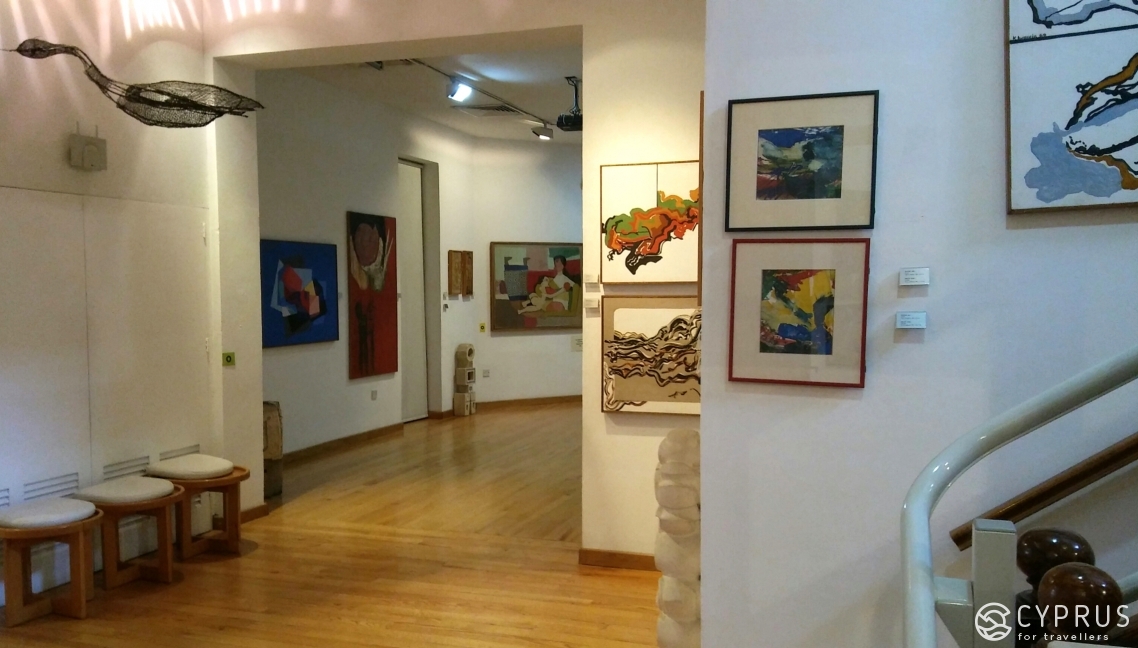
The halls of the second floor (the great halls back in time) that are built according to the traditions of Greek stone constructions of the New and the Newest time are the most spacious rooms in the building. Climbing up the stairs we are immediately finding ourselves in the middle of the hall: the “bird” made of metal framework is hovering over you.
There are also several widely known abstract decorative artworks (created in 1970) of Costas Joachim (born in 1936) whose works you can also see in many museums and private collections around the island. He made the image of a human the main theme of his artworks and, according to his words “…invented a technique to show the volume, simplicity, sincerity and direct setting on canvas through the abstraction from a figure”.
On the second floor you can also see few spatial objects by Christoforos Savva: cubic ceramic abstract sculpture — an imitation of apartment building or some kind of temple loosely decorated with mosaic elements or even archaic tomb with the staircase going down its well that became visible when you are looking down on it. Some kind of historical reminiscence or something like that… Right over this object you will see abstract paintings by Stella Michaelidou from the series “Fire, Water and Ground” (1995).
Kate Stephanidou (1925-2012), typical for her paintings are high decorativeness (“Untitled”, acryl paints on canvas) and abstract artistic decision that reminds the art works of Joan Miro, most likely influenced Stephanidou.
Glyn Hughes (1935-2011); retrospective exhibition of his works, as you might know from our previous articles, was organized recently in NiMAC (Nicosia Municipal Arts Centre). Read about it here. So, we are already familiar with his works now. He was a Britain painter and writer, pioneer of performance in Cyprus, who lived here many years and deepened into the spiritual and folk culture. His painting “Ayios Theodoros” (1962, oil on canvas) is a part of the collection in the Gallery.
Near his painting, as it was always in his life, are the works of his friend Ch. Savva: abstract half-sculptured compositions made from tinted alabaster: “Anadyomene” (Sea-born) and “The Soldier” (both created in 1962-65). Another his artwork is a panel “Motherhood” (1965) made in the technique of patchwork and impresses with its warm, originality of design and fresh artistic look. His artworks made of tacks show the breadth of talent of this Cypriot artist that unfortunately passed so soon, but who managed to cover many art styles and directions of the 20th century: from fauvism and cubism to abstractionism and non-figurative art.
And of course it’s impossible not to mention his picturesque “Woman with flowers” (1966-67) — patchwork and mixed techniques — an artwork full of humour and recognizable details…and even admiring unflappable dignity of his model by the artist.
Here are also earlier parts of his art heritage: a still life and a landscape (both created in the end of 1950es) influenced by French fauvist Henri Matisse and postimpressionist Paul Cézanne.

You can find plenty of works of Marios Loizides (1928-1988), one of the geometric abstractionists in Cyprus, in the main hall to the right together with paradigmatic artworks of Stass Paraskos (1933-2014). His “Pagan Spring” is a great remarkable expressive panel composed like a collage from different images, symbolic elements of Greek and antique culture as the individual frames (1968, oil on canvas).
Paraskos’ artistic style is widely known in Cyprus and abroad as a far from naturalism figurative art characterized by incredibly bright colour palette and bold local colour combinations.
The small hall nearby contains expressive artworks of Michlis Demetris (born in 1947) and Xenia Panteli (born in 1950) as well as abstract sculpture created by Konstantinos Dimitris (born in 1924) — modern interpretation of archaic “Kore”, made of wood and metal (1965).
I’ve noticed it a while ago that many male Greek sculptors turn to the theme of Kore-maidens. Even in the permanent exposition here in the Gallery you will see Kores in various interpretations, what is very curious!
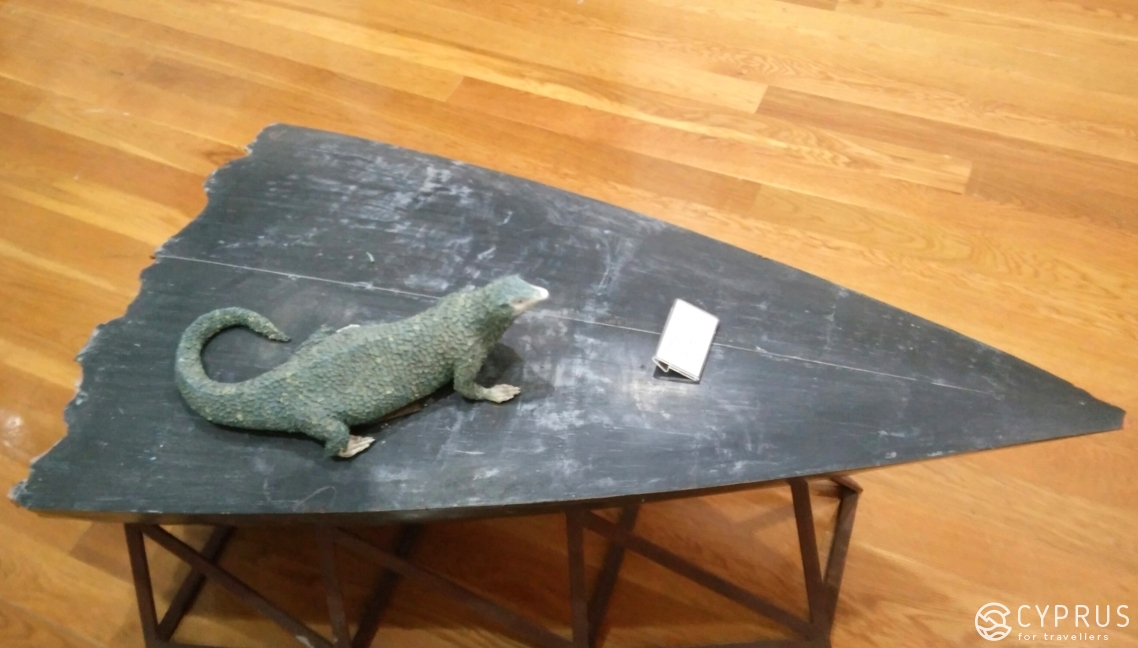
The furthest hall from the stairs tells about facets of historical destinies of Cyprus reflected in the artworks of its sons and daughters. The artwork in its centre is “A Boat” (1988, mixed techniques) by Giorgos Kypris: the front part of “invisible” boat with a realistic komodo dragon sitting on it.
Near it are paintings (artworks created in 1970-90es) of such contemporary masters as Andreas Charalampous (“Self Portrait”) and Andreas Karayian (born in 1943) — “Heroes”, “Reflections” and others, and wooden sculpture like an allusion to historical themes.
Another three small exhibition rooms are located to the left from the staircase. In the first are the artworks of painters that worked in other styles: symbolic painting by Loukia Vassiliou Nicolaidou — a portrait of mother and daughter named “The Good fruit of the Earth” painted in bright but calm tones (created between 1930 and 1940).
The theme of motherhood is represented in this hall: paintings and sculptures by Paulina Pavlidou (1922-1993) and her bronze sculpture “Mother and child” (1967), made in mixed techniques monumental collage works (1992) of Andreas (Antis) Ioannides (born in 1939) are full of love to mother and an intimate connection between the generations (“The second letter to the mother” and others).
Here are also several foreign artists: British painter that became a Cypriot one — John Corbidge (born in 1935) and his abstract landscape “Imperial Sunset” (1969).
Near it are the artworks (created in 1970es) of Turk-Cypriot [4] master Yilmaz H. Hakeri (born in 1944).
Another famous artists whose creations are shown here are: monumental artist Chrystos Foukaras (born in 1944), the visitors will see his artwork “St. George and the Dragon”; Yorgos Skotinos (born in 1937) — his great surrealistic artwork “Metabolism” (1969, acryl paints and oil on canvas). The title suits it well by the way.
-
In the next room we will meet realistic paintings: the most famous one is created by Andreas Ladommatos — “Afternoon light on stones and dry weeds” (1988-90) and others showing one of the Cyprus common motives — stones and grassland.
Bronze sculpture “Ajacs” (1994) by Andros Kazamias — the hero is pulling the string back of his bow — excessive shapes of his body and tension within his posture symbolize recurring theme of struggle.
Two paintings of academic art by George Kotsonis (born in 1940) depicting female characters: a portrait (1996) and a nude painting (1978). Abstract landscapes, very pleasant in colour presented by artworks of Eleni Hariklidou.
The last hall on the second floor represents geometric and op-art styles of the island. These works were created in the period between 60es and 80es by Andreas Savvides (1930-2016) and Vera Hadjida (1936-2012) with her expressionistic abstractionism and usage of geometrical shapes.
There are also artworks of famous artist Stelios Votsis (1929-2012) whose paintings could be found in many galleries and private collections in Cyprus.
You will definitely like several installations constructed by famous decorator and theatre costume designer Nikos Kouroussis (born in 1937): “Untitled” made of wood and another one made of Plexiglas using mixed techniques (1970) by George Sfikas (born in 1943).
You can see another amazing in its allegory artwork located in the middle of the hall under the horizontal glass window. Its main subject is books, information and diversity of meanings. I haven’t seen any other explanations on the shields near the exhibit, so it leaves the further interpretation to the observers.
Take a look at the interesting work of Cyprus significant artist Turk-Cypriot Inatchi Umit (born in 1960) — “Mausoleum” (1996, acryl paints on canvas) while going up to the third floor.

And now we are on the last floor of the permanent exhibition. Here in quite small rooms you will find the works of young but already recognized generation of Cyprus artists: painters, sculptors and ceramists.
The exhibition in the main hall near the stairs begins with two modern sculptures created by Koula Savvidou (born in 1956) looking on the visitors with their observant eyes: “Sleep — walker’s Dream” (1990, mixed techniques, or “Sphynx” as I called it to myself because of many clearly visible analogies) and “The recluses passage” (also in mixed techniques) that stands below. In front of it on the wall is monumental abstract painting, very tense in its mood and red colour tones, named “Sarcophagus” (1994) by Nikodemou Eleni (born in 1955).
Following art objects are created by modern sculptor Theodoulos Gregoriou: carrying different kind of mood, making graphic and sharp impression on the observer “Proplasma” (1987) created using mixed techniques: painting, collage, alabaster and metal details etc.
Art object “A Chest of Masks” (1988) by Ioannis Antoniou (born in 1955); a glass box similar to old cumbersome luggage with the rope winded around it… the “masks” carelessly lie inside it — old memories and worries…the box seems too heavy to carry and stayed in the exhibition hall like an unwanted ballast left on the halfway.
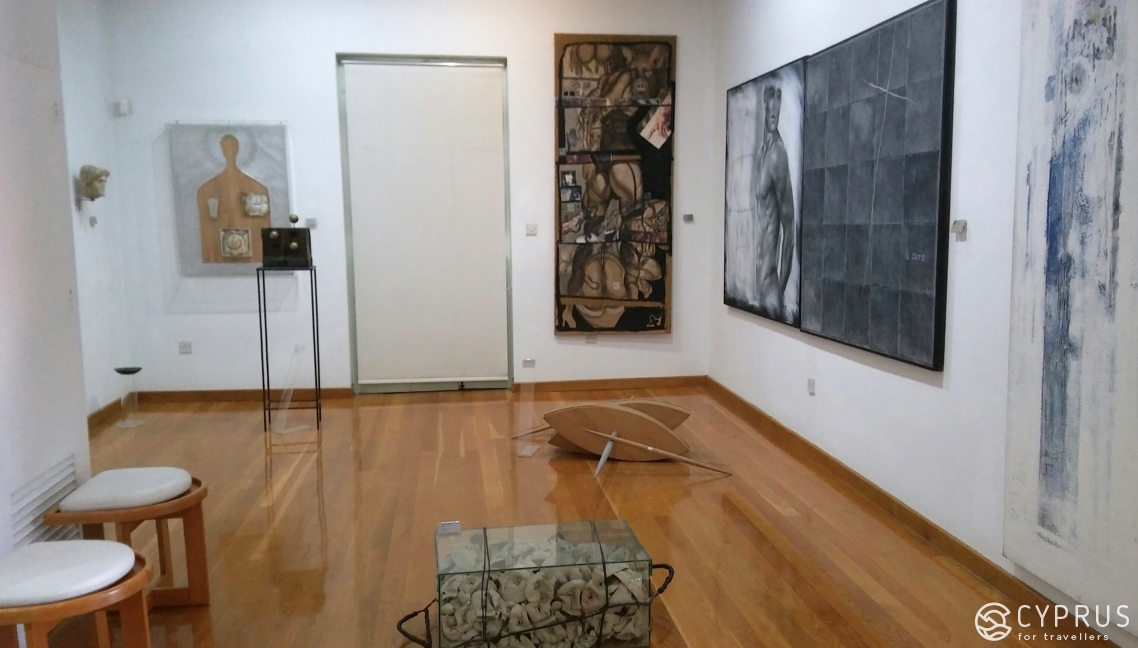
Another object that seems to be left too is “A Horse” (1989) — delicate work by Maria Loizidou, but it brings the opposite kind of memories with it — warm impressions and first experiences from the childhood. Inside the horse you can find, despite the allusion to the “Trojan horse”, several objects that many of you will associate with the heartbreaking sense of peaceful joy every kid felt at least once in his life.
Here, in contrast to other halls we’ve already visited, where the artworks showed the participation of artists and their interest to dramatic events in the life of Cypriots, hard work of the villagers back in time and twists and turns in people destinies, you will see another inspiring theme — the sea; the sea in its eternity, magnificence and serenity that stays tricky with its deep waters hiding various dangers under it.
Of course you will want to look closer at the one of installations: small paper ships seem so light, peaceful and defenseless against a background of black depth… (“Surpassing”, 1986, created by Nikos Kurussis, mixed techniques). By the way the photos of this artwork are often used in different articles and social networks.

You will see another interpretation of Kore-maidens represented by one of the three works of Angelos Makrides (born in 1942). This image made using alabaster cast, fabric and other kinds of mixed techniques reminds of some ancient Greek tragedies. Another figure near Kore — melancholic and floating “Bride” (1985) is also a bit theatrical early work that shows a turn to the traditions and floating time, which adds mortality to this celebration symbol… The third artwork of this artist is a woman’s head “Wiping maiden” (mixed technique, 1991) that reflects again the historical and cultural heritage.
Antonis Antonios (born in 1940) — “The 5th sphere” (bronze, 2000) — the art object is a realistic imitation of the old wood piece with the showing and hiding golden spheres around it.
In front of it we will see full of modern spirit artworks of Andreas Makariou (born in 1955), through which the artist tries to reflect the realities of the contemporary society, as well as his “collegue” Stavros Antonopoulos (born in 1962) in his monochrome and quite philosophical diptych “Miles to go before…” (mixed technique, 1990).
The theme of Cyprus and its sorrows continues in a small room to the left: a series of xylography (wood-engraving from 1940es-70es) created by one of the famous Cypriot artists — Kantos Telemachos, whose works we’ve already met downstairs. The series begins with earlier artworks picturing country life routines and reach its climax in tragic gravures “The Black Sunday”, “Rachel”, “Four Prisoners” and others.
The next exhibited artwork is an avant-garde silkscreen (print on silk) “The women return” (1989) by famous graphic artist Hambiz (Tsangaris, born in 1947); “Our homes — 1” and “Our homes — 5” are also one of his works.
Dramatic past is reflected in another art object created by Antonis Antonios “He wanted to live free” (Ηθελε να ζησει ελεύθερος): a marble desk with small epitaph sign with the mousetrap on it. The mousetrap is cutting a golden sphere in halves — as a symbol of an oblivion waiting for the humans in the end of their lives.
Another abstract bronze sculpture by Constantinos Demetris (1924-2010) is located nearby — “Geometric synetic” (1968).
Ending our review, let’s stay together for a while in front of triptych created by talented painter Anna Constantionou (born in 1947) — an abstract scene (1987) in which colour spots nature and landscapes could be guessed.

So we’ve finished our excursion in the State Gallery of Contemporary Art, but there are some good news we want to share with you. It is planned to expand the roomage of the exhibition areas through the new building complex in the old town (the authors of the projects are Omeros Morphakis, Yorgos Georgiou and Chrystos Savva).
The new building of State Gallery in Nicosia (so called SPEL building) will be located opposite the Famagusta Gate. The total area of five levels (basement for the archives, ofices, three exhibition halls and a terrace) is 3.360 sq. m.
New Gallery and the staff will focus its activities on exhibiting and popularization of the latest artworks created by Cypriot artists while the existing building on Stasinou Street will continue its work as a retrospective gallery of Cypriot art.
You will find the Gallery here:
Address: at the corner of Stasinou and Crete, 1.
Opening hours: Tue — Fri, 10:00 — 16:40; Sat 10:00 — 12:45.
Closed in August and during the official holidays.
The entrance ticket is free.
Contacts and other detailed information:
Phone: +357 22458228
Website: www.moec.gov.cy
Email: stategallery@culture.moec.gov.cy
The Gallery building is suitable for people with reduced mobility.
Several municipal car parking lots in Nicosia are within walking distance — near the walls of the old town and on the Stasinou Street, as well as a bus station on the Agalma Square (also near the old town).
Short introductory virtual tour through the Gallery halls is available here.
We wish to sincerely thank the State Gallery of Contemporary Art in Nicosia and its staff members for the help with this article and for the provided access to the rare sources.
Stay with us and utill new meetings!
[1] For your information: the collection of the Gallery is constantly growing and enriching by new names and great artworks, so the permanent exposition could slightly change by the time you will visit it in Nicosia.
[2] A hospital and a hotel were also located in this building in the past during different periods of time. The building is by the way one of the oldest among the houses near the walls of the old town.
[3] See also: A century of visual art. Works from the State collection of Contemporary Cypriot Art. — Ministry of Education and Culture (Cultural services), “Thessaloniki”, 1997.
[4] A rich collection of artworks by Turk-Cypriots is located today at Ismet V. Güney Art Centre in the north part of Nicosia.

